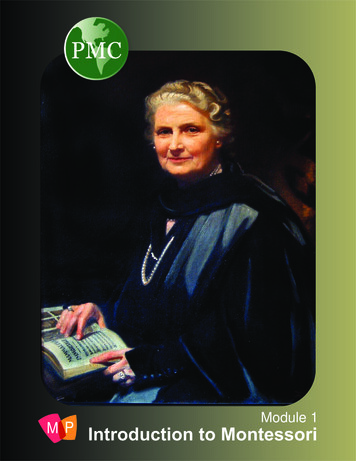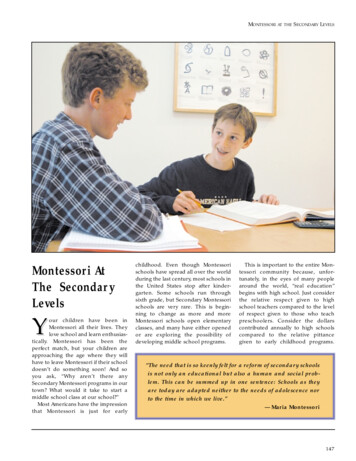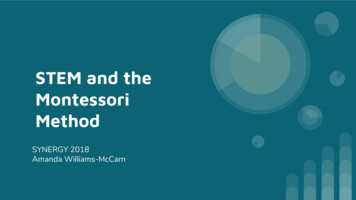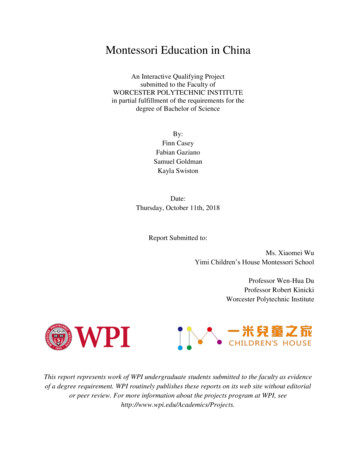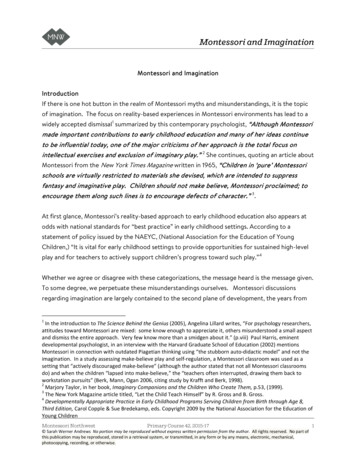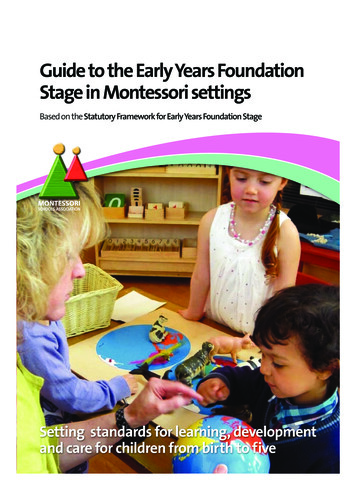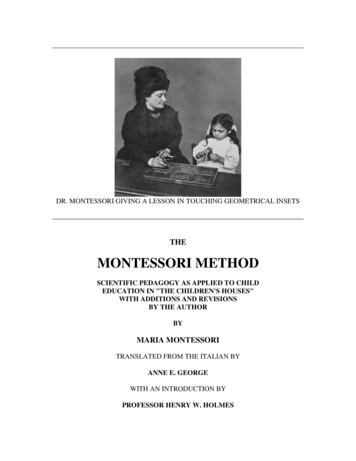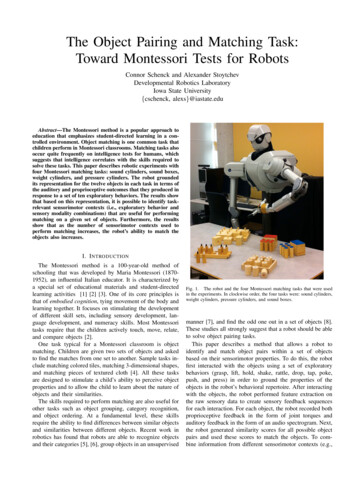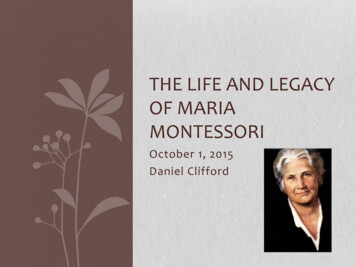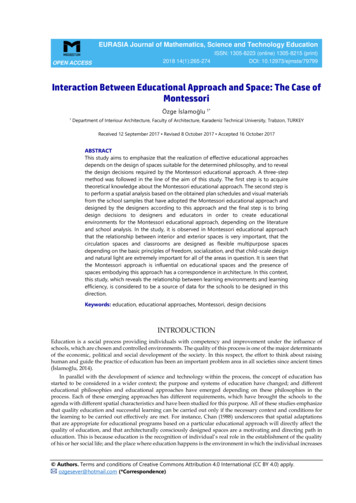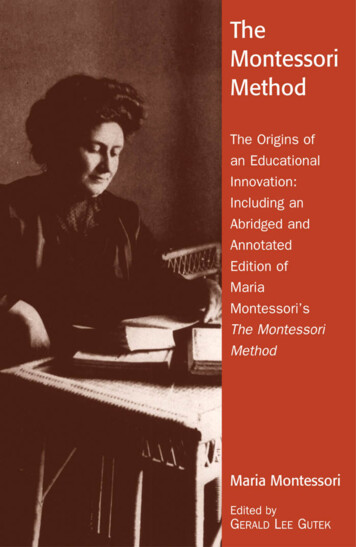
Transcription
The MontessoriMethod
This page was intentionally left blank
The MontessoriMethodThe Origins of anEducational Innovation:Including an Abridged andAnnotated Edition ofMaria Montessori’sThe Montessori MethodMaria Montessori, edited by Gerald Lee GutekROWMAN & LITTLEFIELD PUBLISHERS, INC.Lanham Boulder New York Toronto Oxford
ROWMAN & LITTLEFIELD PUBLISHERS, INC.Published in the United States of Americaby Rowman & Littlefield Publishers, Inc.A wholly owned subsidiary of The Rowman & Littlefield Publishing Group, Inc.4501 Forbes Boulevard, Suite 200, Lanham, MD 20706www.rowmanlittlefield.comP.O. Box 317, Oxford OX2 9RU, UKCopyright 2004 by Rowman & Littlefield Publishers, Inc.All rights reserved. No part of this publication may be reproduced, stored in a retrievalsystem, or transmitted in any form or by any means, electronic, mechanical,photocopying, recording, or otherwise, without the prior permission of the publisher.British Library Cataloguing in Publication Information AvailableLibrary of Congress Cataloging-in-Publication DataMontessori, Maria, 1870–1952.[Metodo della pedagogia scientifica. English]The Montessori method : the origins of an educational innovation,including an abridged and annotated edition of Maria Montessori’s TheMontessori method / Maria Montessori ; edited by Gerald Lee Gutek.p. cm.Includes bibliographical references and index.ISBN 0-7425-1911-2 (cloth : alk. paper)—ISBN 0-7425-1912-0 (pbk. :alk. paper)1. Montessori method of education. 2. Education,Preschool—Philosophy. 3. Montessori, Maria, 1870–1952. 4. Womeneducators—Italy—Biography. I. Gutek, Gerald Lee. II. Title.LB775.M76M6713 2004372.139'2—dc222004000420Printed in the United States of America The paper used in this publication meets the minimum requirements of AmericanNational Standard for Information Sciences—Permanence of Paper for Printed LibraryMaterials, ANSI/NISO Z39.48-1992.
For my grandchildren, Abigail Lee and Luke Kenneth Swiatek,and their parents, Laura Lee and Andrew Swiatek.
This page was intentionally left blank
ContentsEditor’s NoteixIntroduction: A Biography of Montessori and anAnalysis of the Montessori Method1Part I: An Annotated Edition of Maria Montessori’sThe Montessori Method1 A Critical Consideration of the New Pedagogy inIts Relation to Modern Science692 History of Methods813 Inaugural Address Delivered on theOccasion of the Opening of One of the “Children’s Houses”934 Pedagogical Methods Used in the “Children’s Houses”1075 Discipline1136 How the Lessons Should Be Given1237 Exercises of Practical Life1298 Refection—The Child’s Diet1339 Muscular Education—Gymnastics135vii
Contentsviii10 Nature in Education—Agricultural Labor:Culture of Plants and Animals14311 Manual Labor—The Potter’s Art and Building14912 Education of the Senses15313 Education of the Senses and Illustrations of the DidacticMaterial: General Sensibility; the Tactile, Thermic, Baric,and Stereognostic Senses16114 General Notes on the Education of the Senses17715 Intellectual Education18116 Methods for the Teaching of Reading and Writing19517 Description of the Method and Didactic Material Used20518 Language in Childhood22719 Teaching of Numeration: Introduction to Arithmetic23320 Sequence of Exercises24321 General Review of Discipline24922 Conclusions and Impressions261Part II: Related Documents23 Interpretation of Montessori’s Lecture267Translated by Anne E. George24 Excerpts from The Montessori System Examined273William H. KilpatrickAppendix279Bibliography283Index285About the Editor295
Editor’s NoteMaria Montessori and the Montessori Method: The Origins of an Educa tional Innovation creates the context in which Maria Montessori developedher philosophy of early childhood education. It examines how a determinedyoung woman overcame the obstacles that blocked the educational and careeropportunities in Italy during the late Victorian age. Following Montessori,who was the first woman to earn a medical degree from the University ofRome, the biographical introduction takes her story to the establishment ofthe first Montessori school, the Casa dei Bambini in the slums of Rome. Itthen analyzes the sources and influences that shaped the creation of theMontessori philosophy of education. Special attention is given to TheMontessori Method as the book that introduced this educational innovation toan American audience.This book is divided into several sections. It begins with a biography ofMaria Montessori and an introductory commentary on the Montessori Methodof Education. Part I contains an abridged and annotated edition of MariaMontessori’s Montessori Method (1912). Part II contains related documents.The biography of Montessori (1870–1952) discusses her family, education, career in medicine and education, establishment of the first Montessorischool, Casa dei Bambini in Rome, the development of her philosophy andmethod of education, her lecture tour in the United States in 1913, and subsequent events in her life. In examining Montessori’s development of her educational method, it treats the influence of her medical education, especiallythe importance given to clinical observation and the use of science. The influence of Itard and Seguin, two French physicians and educators, who developed methods for educating children with physical and mental handicapsix
xEditor’s Noteis discussed. An important section of the biography deals with the first attempt to introduce the Montessori method of the United States in 1913, especially the efforts of the publicist and journalist, S. S. McClure and AnneE. George, the first American trained by Montessori. The essay followsMontessori from the time of the American lecture tour, to her work in Europe and Asia.The commentary on the Montessori method analyzes how her medical education exercised an influence on her work in education. It then analyzes herconcept of the child, children’s sensitive developmental periods, the educationof the senses, practical skills, and the child’s explosion into reading and writing. The Montessori curriculum and didactic materials are discussed. The section concludes with Montessori’s ideas on moral development and education.Part I is an annotated and abridged edition of Maria Montessori’s, TheMontessori Method. This English language translation by Anne E. George ishighly important in the Montessori literature because it served as the first major introduction to her method in the United States. When read as a background to her first lecture tour of the United States, it provides a clear and detailed discussion of the Montessori method. The book became a best-sellingnonfiction work in the year of its publication. The editor provides a series ofexplanatory notes to persons and trends mentioned by Montessori.Part II provides two related documents: (1) Anne E. George’s notes thatwere used in the translation of Montessori’s lectures into English during the1913 speaking tour arranged by the American publisher S. S. McClure; (2) selected critical excerpts from William H. Kilpatrick’s The Montessori SystemExamined (1914). George, trained as a directress by Montessori, was a leading proponent of the method in the United States. She established the firstAmerican Montessori school at Tarrytown, New York. Kilpatrick, a professorof education at Columbia University’s Teachers College, was a disciple ofJohn Dewey’s Pragmatist philosophy. A leading progressive educator, Kilpatrick was highly critical of the Montessori method.NOTEPage number references (indicating deletion) in editor’s notes refer to Montessori’soriginal (1912).
Introduction: ABiography of Montessoriand an Analysis of theMontessori MethodBIOGRAPHYToday, Maria Montessori enjoys global acclaim as one of the world’s greateducators. Her life story is a remarkable one—one in which a dedicatedwoman used her scientific training, her experience, and her insights to develop a method of education that challenged conventional patterns of education. The conventions she challenged were not only educational ones: she hadto surmount the obstacles that limited the freedom of women to enter intonew careers.Maria Montessori was born on August 31, 1870, in Chiaravalle, a hill townoverlooking the Adriatic Sea, in Italy’s Ancona province. She was the onlychild of Alessandro Montessori, a business manager in the state-run tobaccomonopoly; and Renilde Stoppani, the well-educated daughter of a highly respected family.1Maria Montessori was born only ten years after Italy’s unification, underthe House of Savoy. As a result of the “Risorgimento,” led by CamilloCavour, a liberal statesman, and Giuseppe Garibaldi, a fiery patriot, the smallstates and principalities on the Italian peninsula were finally united as onecountry in 1871. Giuseppe Garibaldi’s red-shirted volunteer army, the Carbonari, had toppled the old bourbon kingdom of the “Two Sicilies,” and thearmies of Piedmont-Sardinia had brought Victor Emmanuel to Italy’s throneas a constitutional monarch.The new Italy was a product of the forces of nationalism and liberalism.Nationalists, such as Garibaldi, wanted Italy to take its place in the politicalsun. Liberals such as Cavour wanted to move Italy forward as a modern industrialized nation. Strong remnants of conservatism and traditionalism,1
2Introductionhowever, resisted Italy’s modernization. Serious opposition came from thepope, who, smarting from the annexation of the Papal States to Italy and regarding himself as the “prisoner of the Vatican,” refused to recognize thenew political reality. Maria Montessori’s uncle, Antonio Stoppani, a notednaturalist and Roman Catholic priest, called for reconciliation betweenchurch and state. Maria’s father, Alessandro, while remaining a committedCatholic, took a position in the new state’s civil service.Although Italy’s emergence as a sovereign nation was recent, Italian culture reached back to the antiquity of ancient Rome. The new nation in whichMontessori was born, in 1870, remained still very much the old, traditional,and conservative Italy. Although industrialization was slowly changing theclass structure, social and gender roles were inherited across time and generations. La famiglia, the family, was the primary focus of most Italians’ identification, loyalty, and commitment. A person’s education and career remained largely determined by family background and social status. Thechildren of peasants were destined to take their parents’ place on Italy’s farmsand landed estates. Middle-class males were likely to oversee estates, managebusinesses, or engage in commerce. Children of the landed aristocracy wouldcontinue to enjoy the benefits of inherited wealth that made them a leisureclass.If family and class determined the status and careers of Italian males,women’s roles were even more fixed by custom and tradition. While membership in a particular class was a conditioning factor, women were expectedto become the central sustaining force in their families as wives and mothers.With their roles so determined, higher and professional education were notusually accessible to women. Society allowed and economic necessity required women of the lower socioeconomic classes to work as agricultural, domestic, or factory laborers. Daughters of the lower-middle class might become elementary school teachers or nurses. Young women of the aristocracymight attend finishing schools or convent schools to learn art, music, and literature. Challenging Italy’s nineteenth-century gender conventions, MariaMontessori would enter a technical secondary school to study engineeringand, later, the University of Rome’s medical school to become Italy’s first degreed female physician.Alessandro Montessori’s position in the Italian civil service provided hisfamily with economic security. The Montessori family was comfortably situated in the European bourgeoisie, the middle class. Signor Montessori, a decorated veteran of the war for Italian unification in 1848, retained his militarybearing throughout his life. Despite the social and economic transformationthat was taking place in the new Italy, he epitomized the attitudes and valuesof Victorian middle-class respectability. His strong-willed daughter was to
A Biography and an Analysis3challenge many of these traditional expectations about the proper role to beplayed by a young woman.Renilde, Alessandro’s wife, was a niece of Father Antonio Stoppani, ascholar-priest, known for his work as a natural scientist and geologist.Though a traditionally educated middle-class woman, Renilde was more willing to break with tradition than her husband. At certain crucial times, she supported her daughter’s challenges to convention. At first, Alessandro wouldbalk at supporting his daughter and wife, but eventually he acquiesced.In 1875, Alessandro was assigned to a position in Rome, and the Montessori family moved to the Eternal City, and Italy’s capital. Here, in one of themost important centers of Western civilization, Maria, the family’s only child,enrolled in the state elementary school located on the Via di San Nicolo daTolentino. Maria’s education in the local primary school followed the traditional approach that learning comes from the teacher’s transmission of information to children, through textbooks and recitations. The key instructionalroutines involved memorization of textbooks, the recitation, and dictation. InItalian schools, the children often used a single textbook that combined in onevolume all the subjects taught—reading, writing, arithmetic, history, and geography. The recitation method required children to stand at attention whenquestioned by the teacher and provide accurately memorized responses fromthe textbook. Italian schools in particular featured dictation, in which studentswould copy word-for-word statements made by the teacher. Each letter of thealphabet had to be placed squarely in a small box marked on a copybook.While providing basic literary and mathematical skills, traditional schoolsdiscouraged and often punished children’s spontaneity and creativity. In thisview, the teacher held center stage in the classroom, and the student was apassive receptacle of information, which was to be stored in the mind and recalled for examinations and possible use in the future. Later educators suchas Paulo Freire would call this storage-and-retrieval approach to learning the“banking” method of education in which information was deposited andstored for later use.2 When she created her method of education, Montessoriturned this view upside down. The individual child would become the focus,the center of education; and the teacher, a director, who unobtrusively guidedthe child’s own self-learning.The Italian educational system in the late nineteenth century followed the continental European pattern of being heavily class determined. The Cassati Law of1859 provided for the establishment of national primary (or elementary) schools.Compulsory education laws were not rigorously enforced, however. Italy, especially the southern regions, had a high percentage of illiterates.3 At the secondary level, the schools followed the continental European model and were specialized into the highly academic college-preparatory schools, the liceos, and
4Introductioninto a range of technical and vocational schools, specializing in engineering,art, agriculture, and commerce. Only a very small number were admitted touniversity studies. As a member of the middle class, Montessori had the opportunity to complete elementary school. Her determination to pursue a technical secondary education and medical school, however, departed radicallyfrom the educational expectations at the time, which would have sent her toa finishing school, generally operated by a religious order of nuns, or to a normal school to prepare as an elementary school teacher.Maria’s parents carefully monitored their daughter’s education. Her father,who recognized his daughter’s academic abilities, encouraged her study ofmathematics. Although her father sometimes resisted Maria’s unconventionalcareer decisions, her mother generally supported Maria’s decisions. At agetwelve, Maria displayed her characteristic independence by declaring her intention of entering a technical secondary school.In 1883, thirteen-year-old Maria Montessori enrolled in the Regia ScuolaTechnica Michelangelo Buonarroti, a state technical school. As a student inthe Scuola Technica, Maria pursued a seven-year curriculum, approved by thenational ministry, that included Italian literature, French, mathematics such asalgebra and geometry, sciences such as chemistry and physics, history, andgeography. Instruction followed the conventional method of attending lectures, memorizing textbooks, and responding to the instructors’ questionswith structured recitations. Montessori graduated from the technical school inthe spring of 1886 with high marks in her subjects and with a final cumulative grade of 137 out of a possible 150.4Upon completing her studies at the Scuola Technica, Maria next enteredthe Regio Instituto Technico Leonardo da Vinci, in which from 1886 to 1890she studied subjects related to engineering. In 1890, in an important careerdecision, she decided to leave her engineering studies to study medicine. Herapplication to the University of Rome’s School of Medicine was at first rejected by the all-male faculty. The highly determined young woman persisted,and the faculty agreed to admit her to the University of Rome in the fall of1890 as a student of physics, mathematics, and natural sciences. She passedthe examinations for the diploma di licenza in 1892, earning a final grade ofeight out of a possible ten points. She was now academically eligible to begin the actual study of medicine, anatomy, pathology, and clinical work.Montessori was the first woman to be admitted to the medical school.5Since medical studies, like the medical profession, were completely maledominated, Montessori encountered regulations and practices that discriminated against women. Her male colleagues shunned and tried to isolate her.She could not enter a classroom until all the male students were seated. Sincedissection of a naked cadaver was regarded as improper for a woman, she
A Biography and an Analysis5could only use the anatomy laboratory in the evenings, when male studentswere absent. Determined to surmount these obstacles, Montessori distinguished herself, winning scholarships in surgery, pathology, and medicine.6During her last two years of medical school, Montessori studied pediatrics at the Children’s Pediatric Hospital, an experience that moved her toward what would be her lifelong calling. She also served as an adjunct, orassistant, doctor at the women’s hospital of San Salvator al Laterano and atthe Ospedale Santo Spirito for men, in Sassia. In 1896, Maria Montessoriachieved another distinction. She was the first woman in Italy to beawarded the degree of Doctor of Medicine. The twenty-six-year-old physician accepted a position at the university’s San Giovanni Hospital, and shealso began private practice.Montessori’s achievements in education and medicine had made her awoman of distinction in turn-of-the-century Italy. Although her contributionsto the women’s movement have been overshadowed by her achievements ineducation, Montessori was influential in the European women’s movement.She was a member of the Italian delegation to the International Women’sCongress, in Berlin, in September 1896. When tensions between socialist andbourgeois women threatened to disrupt the congress, Montessori, urgingcompromise, argued that the rights of all women, not class and political differences, should be the focus of the women’s movement. In several addressesto the congress, she called for the improvement of Italian women’s social andeconomic status. She urged women to take a leading role in educational reform and to work as literacy volunteers among the poor. She also sponsoreda resolution demanding equal pay for equal work.7In February 1899, Montessori was on a lecture tour, speaking on the “newwoman.” In many respects, she herself was the model for this new woman.According to Montessori, the women of the twentieth century would be the“new women,” in transition from the old order to the new. She was optimisticabout the liberating powers of science and technology that she predictedwould free the new women from the gender-designated drudgery of domesticwork. Science and technology would free them to genuinely fulfill themselves as persons. The process of liberation, she advised, would requirewomen to educate their children according to the new pedagogy based on thescientific study of children’s needs.In developing her case for the new woman, Montessori attacked thestereotypes used to support the theory of female inferiority. She condemnedscholars who, failing to use scientific research, relied on unsubstantiatedclichés about women’s alleged inferiority. Montessori challenged theFrench historian Jules Michelet (1798–1874), who argued that women werenaturally weak and required tutelage and training from the more powerful
6Introductionand intelligent males.8 She discounted the argument of the radical syndicalist theorist Pierre Joseph Proudhon (1809–1865), who, in his critique of thecapitalist economy, argued that capitalism relegated a woman to either being a housewife or a prostitute.9 It should be noted that Proudhon was notarguing that women were limited to these unenviable situations by their nature; rather, the system of private property placed them in subordinate positions. Montessori challenged the Italian criminologist and physician Cesare Lombroso (1835–1909), who was regarded as an expert on criminalanthropology. Montessori stated that there was no scientific support to substantiate Lombroso’s definition of a woman as an incomplete organism in astate of arrested development.10 She firmly rejected the opinion of one ofher former teachers at the University of Rome, the noted anthropologistGiuseppe Sergi, who predicted that women’s social equality would destroythe family and erode the stability of society.11Calling on them to become scholars and scientists, Montessori urgedwomen to overturn the pseudoscientific antiwoman rationales that justifiedkeeping women in second-class status. The triumph of feminism, she predicted, would come, not by polemical counter propaganda, but by social andtechnological inevitability. Science would provide empirical evidence ofwomen’s independence, and equality and technology would reduce the workof the housewife and leave more of her energy and time free. According toMontessori:Eventually, the woman of the future will have equal rights as well as equal duties. She will have a new self-awareness and will find her true strength in anemancipated maternity. Family life as we know it may change, but it is absurdto think that feminism will destroy maternal feelings. The new woman willmarry and have children out of choice, not because matrimony and maternity areimposed on her, and she will exercise control over the health and well being ofthe next generation and inaugurate a reign of peace, because when she can speakknowledgeably in the name of her children and in behalf of her own rights manwill have to listen to her.12Taking her own advice seriously, Montessori became the scientist that sheurged other women to become. Wanting to be more than a medical practitioner,she set out to discover the cause and cure of human illnesses, especially thoseof the mind. She joined the University of Rome’s Clinica Psichiatrica as a voluntary assistant to research her thesis “A Clinical Contribution to the Study ofDelusions of Persecution.” She pursued an in-depth study of the literature onmental illnesses and psychological disorders.13 Her research, too, was movingher closer to a lifelong commitment to early childhood education.
A Biography and an Analysis7Itard and SeguinMontessori’s research on mental retardation and other psychological disorders in children led her to the work of Jean-Marc Gaspard Itard (1774–1838)and Edouard Seguin, (1812–1880) two French physicians and psychologists.Montessori’s study of Itard and Seguin had a highly significant formative influence on the development of her educational method.Itard, a specialist in Otiatria, worked with deaf and hearing-impaired children. He pioneered in transferring the method of clinical observation practiced by physicians of their patients to the educator’s observation of children.His most famous case was his well-publicized treatment of the “wild boy ofAveyron,” a feral youth, apparently abandoned or lost as child, who had beenfound living in the forests with animals. The boy, about age twelve, was without language and practical skills. Itard undertook to educate the boy, traininghim in practical life skills and in speech. While he had some limited gains ineducating the boy, Itard’s experiment did not have promising results. The boy,a difficult pupil with limited abilities, resisted many of Itard’s efforts.14Itard’s experiment with the “wild boy” and his work with mentallyimpaired children led him to theorize that human beings went through specific, definite, and necessary stages of human growth. Itard was not the firsteducational theorist to emphasize the importance of stages of human development. The Roman rhetorician Quintilian (ca. AD 35–100), the Czech theologian and educator John Amos Comenius (1592–1670), and the Frenchphilospher Jean-Jacques Rousseau (1712–1778) had all recognized the crucial importance of developmental stages in education. Unlike these earlier educators who based their ideas about development on introspection or reflection, Itard came to his ideas through empirical observation of actual children.According to Itard, children experienced their stages of development by engaging in activities that were appropriate to the particular period and forwhich they were physiologically and psychologically ready. However, abnormal children, especially those who were severely impaired physically or mentally, tended to miss the full potential of the development stage and were leftwith deficits that impaired their further growth.15 He concluded that childrenneeded to experience the activities appropriate to their stage of developmentat the right time or else suffer the consequence of continual and cumulativeimpairment.16Itard’s work touched on several important themes: nature and natural education and the degree to which human intelligence is hereditary or learned. Acontrast can be made between Rousseau’s fictional “noble savage,” Emile,who, isolated from society, learns primarily though direct sensory interactions. While Rousseau’s Emile grows into a benevolent natural man, Itard’s
8Introductionwork with the real wild boy was quite different. Unlike Emile’s laissez-faireand permissive tutor, Itard sought to find specific ways to train the child. Indealing with intelligence, Itard found that intelligence, while a given, developed by having the appropriate experiences at the right time of development.Montessori was deeply impressed by Itard’s work. A physician like Itard,Montessori was trained in clinical observation. Readily accepting Itard’sideas on empirical observation, she called his efforts practically “the first attempts at experimental psychology.”17Seguin, a physician, who had studied medicine with Itard, worked withmentally impaired children and applied his methods at the Hospice de Bicetre, a training school for children taken from the insane asylums of Paris.18Seguin believed that institutions for handicapped children should becomecenters of training and education and that both medical and pedagogicalknowledge should be used to treat the handicapping condition. He increasingly emphasized the physiological measurement and observation of the childas a means to diagnosis, treatment, and education. Seguin devised a series ofdidactic apparatus and materials to train the senses and improve the physicalskills of children with mental handicaps. In his work with these children,Seguin developed several techniques that would be adopted by Montessori,such as basing instruction on developmental stages using didactic trainingmaterials and training children to perform practical skills so that they couldachieve some degree of independence.19 Seguin’s pioneering efforts in specialeducation were a catalyst that stimulated Montessori to delve more deeplyinto education. From the work of Itard and Seguin, Montessori developed twoprinciples: first, that mental deficiency required a special kind of educationand not only medical treatment; second, that this special kind of educationwas enhanced by the use of didactic materials and apparatus. However, in theeducation of mentally deficient children and, indeed, all children, theteacher’s activities were spiritual in that it was necessary to act on the spiritof the child, which was a “sort of secret key.”20Education of Children with Mental HandicapsIn September 1898, Montessori addressed the Pedagogical Congress in Turinon the subject of the education of mentally retarded children. At that time,mental retardation was not categorically defined but included a range of children, including those who were physiologically impaired as well as those whowere referred to as “laggards,” delinquent, and emotionally disturbed children.Condemning the prevailing practice of confining mentally impaired childrento insane asylums with adults, she urged that they be admitted to educationalinstitutions. Arguing that mental retardation was primarily a pedagogical problem, rather than a medical one, she recommended that these problem children
A Biography and an Analysis9be gathered together in special educational environments. This separation, sheargued, would free the teacher of regular classes from having to cope with serious cases
Montessori Method BIOGRAPHY T oday, Maria Montessori enjoys global acclaim as one of the world’s great educators. Her life story is a remarkable one—one in which a dedicated woman used her scientific training, her experience, and her insights to de-velop a method of educa
